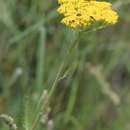en
names in breadcrumbs


Achillea filipendulina, the yarrow, fernleaf yarrow,[2] milfoil, or nosebleed,[3] is an Asian species of flowering plant in the sunflower family, native to central and southwestern Asia (Kazakhstan, Afghanistan, Pakistan, Iran, Iraq, Turkey, Caucasus).[4] It is also naturalized in parts of Europe and North America.[5][6]
A herbaceous perennial, it grows 120 centimetres (4 feet) high, with fern-like foliage. The leaves are linear, pinnate, lobed and serrated, hairy and rough. The flowers are arranged in corymbs, or panicles, of a complex character; they are very large, often 13 cm (5 inches) across. The smaller corymbs are arched or convex, causing the cluster or compound corymb to present an uneven surface. In the species the small flowers are of rich 'old gold' yellow colour, and are very rigid, almost hard. The flowering period is mid to late summer.[4]
Achillea filipendulina is cultivated in temperate regions as a flowering ornamental plant. Ordinary garden loam and other soils support its growth. It is best grown in full sun, and is drought tolerant when established. Propagation is by seed or root division in spring.[7]
The species has generally been superseded by numerous improved cultivars, of which the following have gained the Royal Horticultural Society's Award of Garden Merit:-
Achillea filipendulina, the yarrow, fernleaf yarrow, milfoil, or nosebleed, is an Asian species of flowering plant in the sunflower family, native to central and southwestern Asia (Kazakhstan, Afghanistan, Pakistan, Iran, Iraq, Turkey, Caucasus). It is also naturalized in parts of Europe and North America.